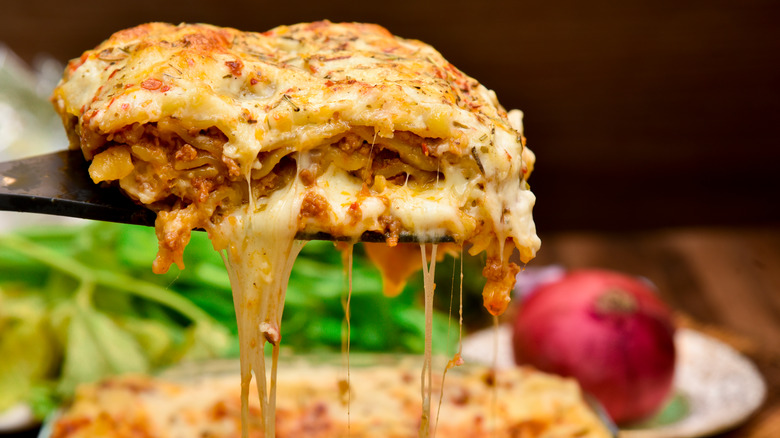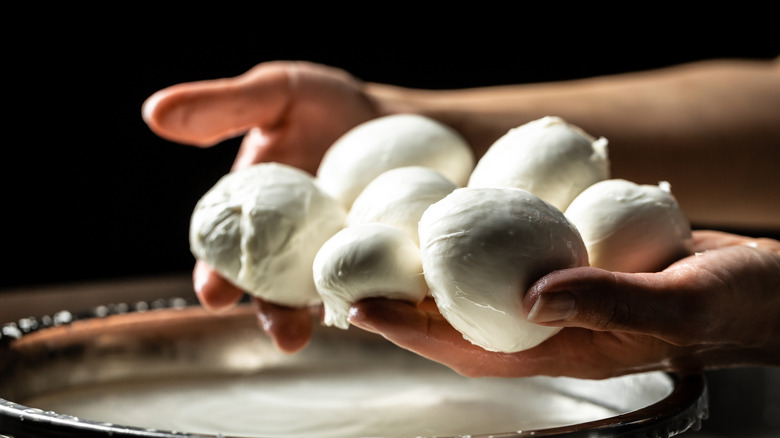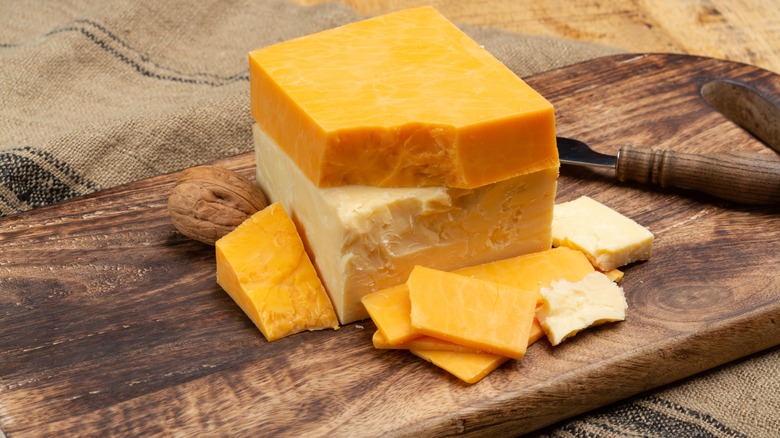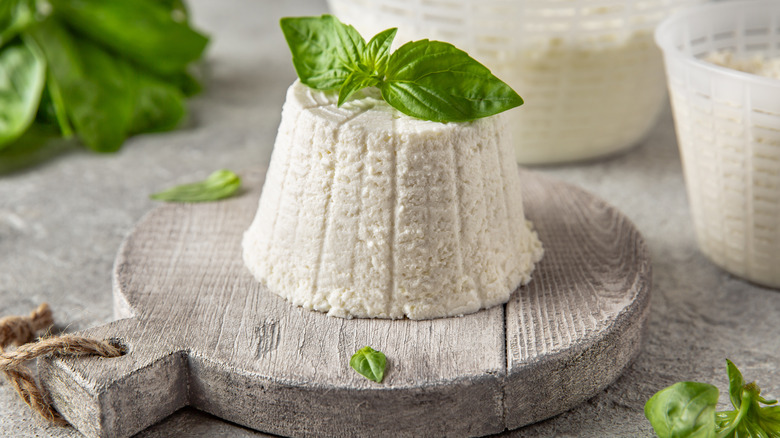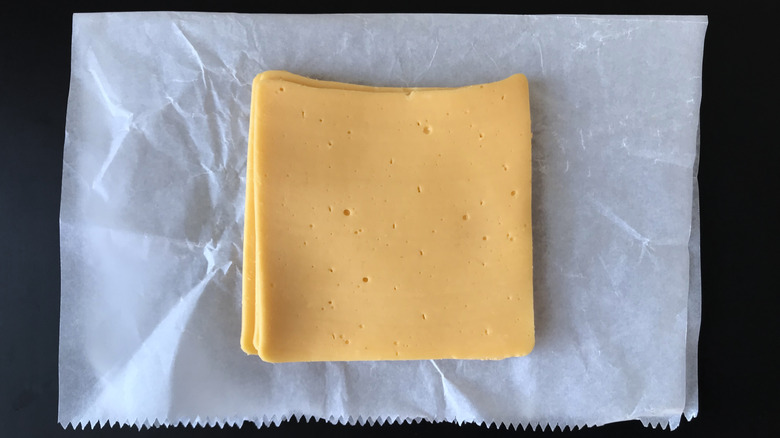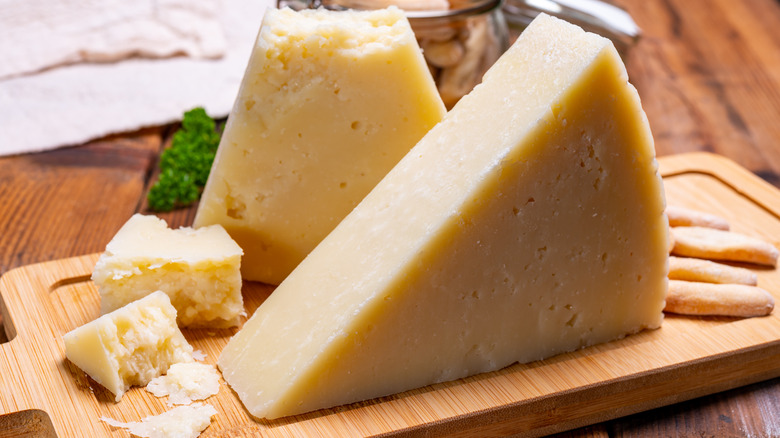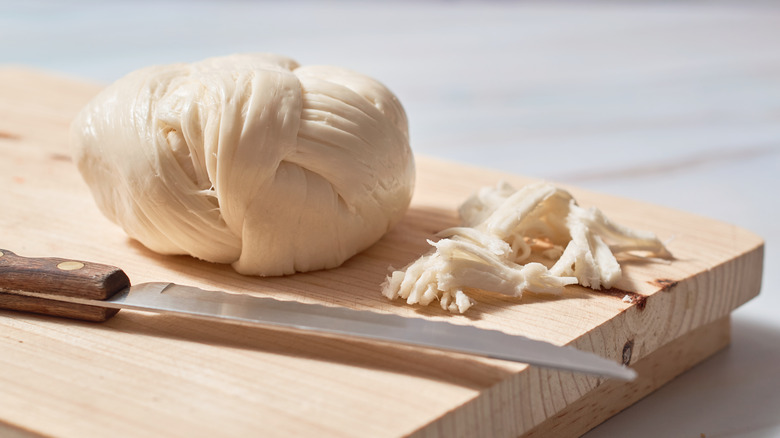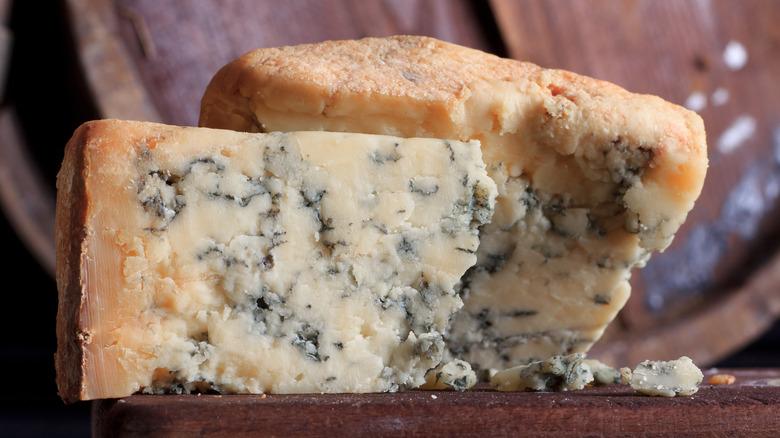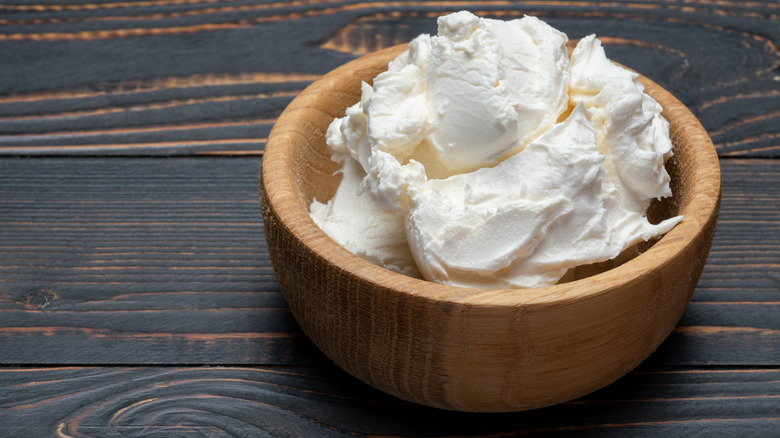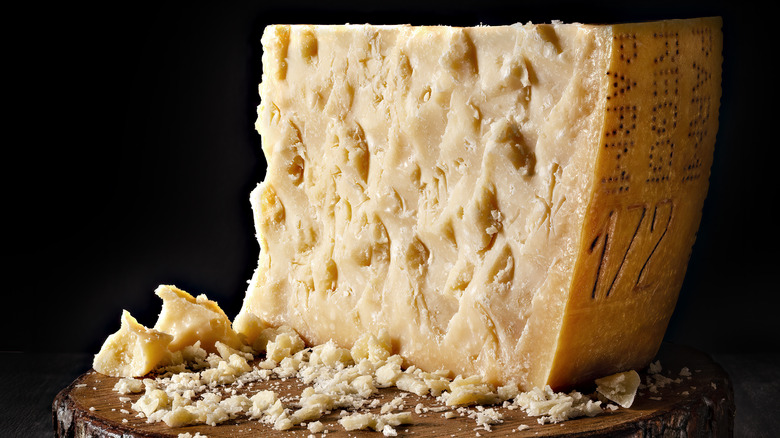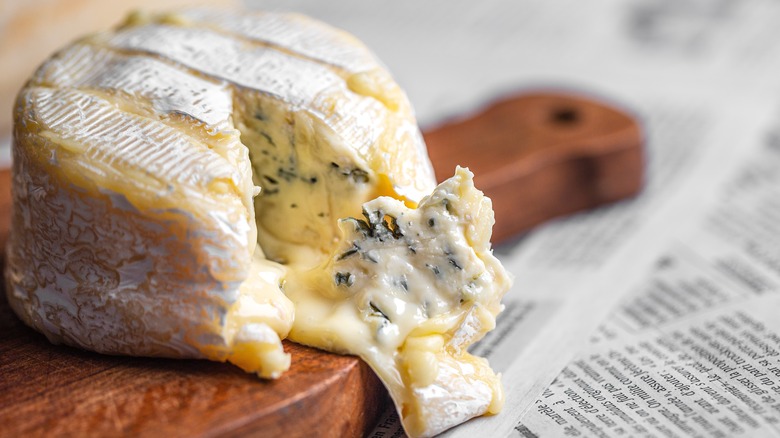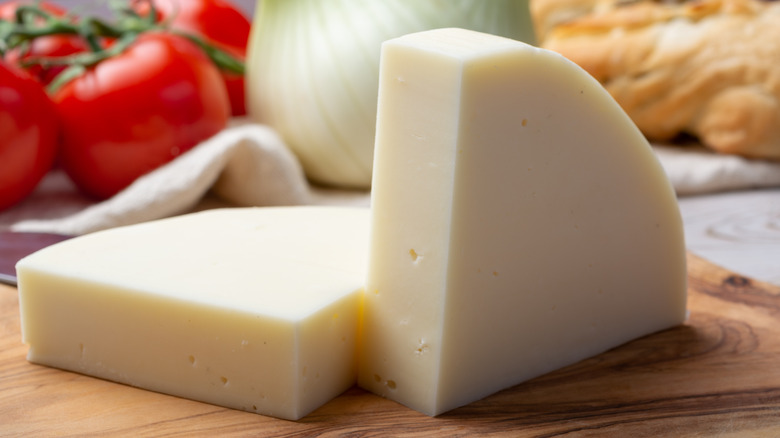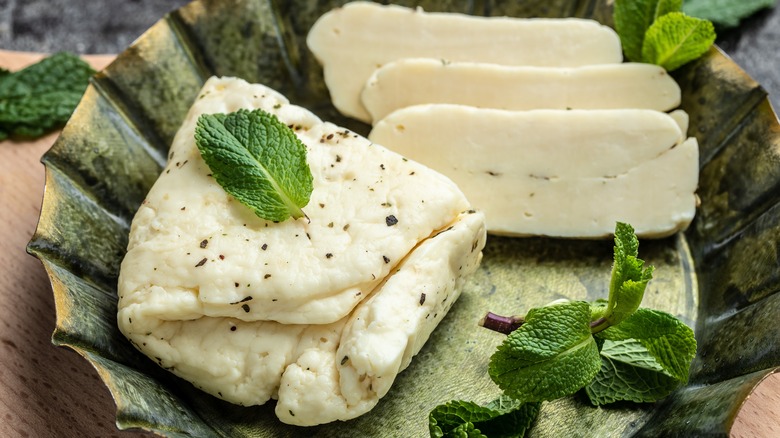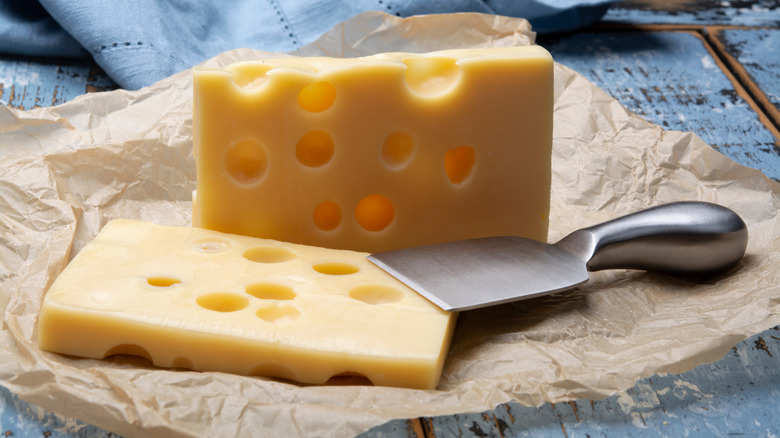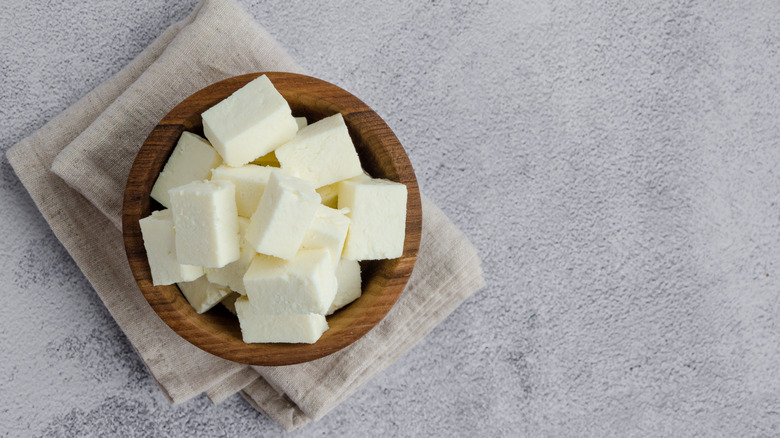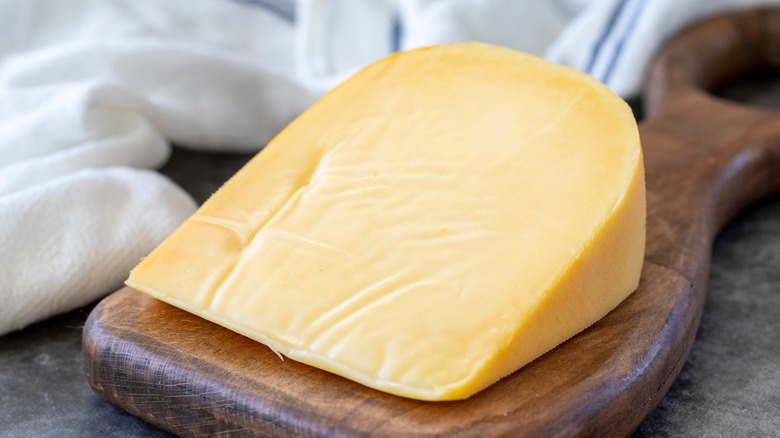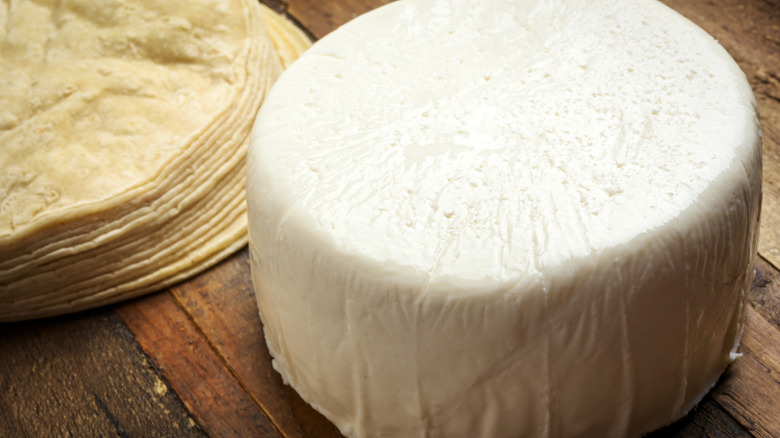8 Cheeses You Should Be Using In Your Lasagna, And 8 You Might Want To Leave Out
Over time, lasagna has taken a fair share of recipe attempts ranging from trend-setting to downright outrageous (Italians are known to overreact). But one thing that has always kept every lasagna together (quite literally) is the soft, melting sea of cheese with the crispy bits on the top. If not for the cheese, lasagna, or "lagana," as it was called back in Roman times, would be a dull casserole dish nobody talks about. We could say the same of the lasagna made with the wrong type of cheese — make this mistake, and you'll be remembered as someone to never accept an invitation for a lasagna dinner from.
Whether you want to make classic Italian lasagna or fiddle with your own version, you have to start with base cheese that serves as an undertone to the complex, more nuanced flavors in your lasagna. Once you have that, you can play with the more pronounced cheeses that will define the final character of your dish. The key to great lasagna cheese is its ability to melt, flavor, and final texture (when baked).
With those qualities in mind, we've scoured the cheese aisle and scrutinized each wheel and block, seeking the cheeses that will take your lasagna to the next level and those that won't. In this guide, we'll explain how every cheese can make or break your lasagna and what other ingredients to tag along with them.
Use: Mozzarella
Mozzarella cheese needs no introduction. Its velvety, melt-in-your-mouth profile has made it a staple in countless Italian recipes. This fresh cheese made from stretched curd (buffalo or cow milk) can be used fresh when making pizza, makes for beautiful antipasti, and certainly has a celebrity status when it comes to making lasagna.
Mozzarella's flavor is subtle, allowing it to blend with other lasagna ingredients. It brings a gentle creaminess that coats each layer with its delicate richness. The soft and smooth texture ensures a satisfying mouthfeel in each bite. However, mozzarella has a high moisture content that may make your lasagna a tad sloppy if you're being overly generous. Remember to always drain it really well before scattering it over your lasagna.
Alternatively, you could use semi-hard mozzarella. It is a firmer and more rubbery type of mozzarella, usually sold in blocks or shredded, which offers far less watery consistency when baked. Semi-hard mozzarella also has a slightly stronger and saltier flavor than fresh mozzarella, and it melts well without becoming stringy. A good thing is you can go heavier on it, and it will still hold the shape beautifully between layers of pasta.
Leave out: Cheddar
Cheddar holds a special place in the world of cheeses. It originates from the English village of Cheddar in Somerset, and its sharp flavor and distinct orange color have made it a household name across the globe. Aged to perfection, cheddar offers a robust and tangy flavor and has earned it a place in countless recipes — an excellent choice for cheeseboards and sandwiches. Not so much for lasagna, however.
The taste of Cheddar is marked by its tangy bite, which can range from mild to extra sharp. Its texture varies from crumbly to creamy, depending on the age of the cheese. Mature cheddar boasts a drier texture and a more intense flavor. This assertive sharpness can easily overpower whatever is happening within the lasagna. Cheddar doesn't melt as smoothly as some other cheeses as well, which could leave the texture of your lasagna inconsistent.
If you're desperate to sneak some cheddar inside your lasagna, you could get away with some mild variety mixed in with some other cheese like mozzarella or gouda — just don't tell your Italian friends you did that.
Use: Ricotta
We certainly have a sweet spot for ricotta lasagna. It brings a unique edge to the dish that is hard to replicate with any other cheese. This ancient Roman cheese is simply remarkable. The curds used to make ricotta are gently cooked, ensuring a delicate and grainy texture that works wonders when cooked in lasagna. It has everything you'd want: It's soft, creamy, and has a mild, subtle sweetness.
To make the most of ricotta, always pick the best-supporting ingredients. A hint of nutmeg can enhance the cheese's delicate sweetness, while spinach adds a verdant earthiness to the dish when wilted and mixed in with the cheese. Try also grating some fresh lemon zest for a fragrant finish. If that's not enough cheese, mozzarella is the perfect partner in crime. With its soft, light texture, it perfectly complements the creamy ricotta.
Before you run off into the kitchen, there are some tricks for you to keep in mind. First, don't skimp on the quality of ricotta — by fresh and only the best (We mean it). Spread it generously between the layers, paying particular attention to the corners and edges to create an even luscious texture. Another (crucial) step is to let your lasagna rest before serving. If you allow the ricotta to set a little, it will make the cutting and handling much easier.
Leave out: American cheese
One of the standout qualities of American cheese is its ability to melt effortlessly, creating almost surreal-like gooeyness. We admit it has its place and uses. When it comes to a classic grilled cheese toastie, even the most prominent food snobs turn a blind eye to its artificial profile (it sits on the border of not being a cheese). However, if we try to replicate this in the lasagna, to say you'll get subpar results would be a slight understatement.
American cheese will melt, and it will turn very, very gooey. It might even look rather inviting. Sadly, the flavor and texture is quite disappointing. It is more disappointing than the origin story of the cheese (it was invented to reduce cheese waste by melting scraps from different cheese batches). The way it melts and then starts forming a plastic-like film as soon as it starts cooling is the single (most important) reason to keep it out of your lasagna.
Lasagna is one of those rare pasta dishes that becomes better with time. If you make a big batch and load it with American cheese, the next time you reheat it, it will make things much worse. To put a final word for it: there are too many better alternatives for you to experience mediocre results.
Use: Romano
Romano cheese is a hard, salty Italian cheese that has been a staple of Italian dishes for centuries. If you're looking for a cheese that adds interesting complexity to your lasagna, Romano is your pick. This ancient cheese is usually made from cows (Vacchino Romano), sheep (Pecorino Romano), or goat's milk (Caprino Romano) and has a slightly grainy texture with a sharp, irresistible tanginess. Most cheeses labeled "Romano" in the US are a milder cow's milk variety. You can certainly use it, but if you want a genuinely distinctive bite in your lasagna, choose the authentic Pecorino Romano DOP (Protected Designation of Origin).
Romano opens up with other ingredients that complement its boldness. Ground beef or pork, alongside sautéed onions and garlic, create a good base for its nuttiness. Add it along with a few springs of fresh basil, oregano, and crushed red pepper flakes to elevate its full potential. It's rarely used independently but works incredibly well when mixed in with fresh mozzarella or ricotta.
When using Romano in lasagna, buy it whole and grate it fresh. Preshredded cheese usually loses some of its original pungency. Mix it evenly, making sure every layer gets its fair share, and remember that a little Romano goes a long way — don't overdo it.
Leave out: Oaxaca cheese
Originating from the Oaxaca region of Mexico, Oaxaca cheese is known for its unique stringy texture. It's like the mozzarella's cousin from the south, with a more pronounced character. While it may seem tempting to experiment with Oaxaca in your lasagna because of its soft, delicate consistency (ideal for melting), it also has a very mild yet pronounced tanginess with a squeek-between-your-teeth rubbery texture. Even when you bake it with other ingredients, it sometimes comes through, so it is best left where it belongs — corn tortilla quesadillas or queso fondido with spicy chorizo, where you want that slightly sour bite in your cheese.
If you're feeling adventurous and want to try something different, you could make a Mexican-inspired casserole dish with corn tortillas instead of pasta sheets, spicy tomato sauce, minced meat, and finished with Oaxaca cheese instead of mozzarella. Maybe throw some beans in there as well, and spice it up with cilantro, cumin, oregano, and chili. Would that still be considered a lasagna? We think not.
Use: Gorgonzola
Italy is a land known for its love affair with cheese. In all its blue-veined glory, Gorgonzola comes from the Lombardy and Piedmont regions. This Italian blue cheese has rather old roots, dating back to the 9th century when it was aged in natural caves. Gorgonzola is rich, pungent, and distinctly bold cheese you cannot mistake for anything else.
While not the obvious first choice for lasagna, Gorgonzola strikes a good balance of creamy and crumbly. The blue veins that run through it offer a complex earthiness underlined by a subtle sweetness. Caramelized shallots are the ultimate pairing with Gorgonzola, while lightly toasted walnuts make for a beautiful crumble on your lasagna.
Gorgonzola is a cheese that doesn't shy away from bold companions. You can marry it seamlessly with earthy mushrooms and spinach or throw in some rich bacon. It is also an excellent base for creamy, savory sauces. Mix it with ricotta cheese and eggs to make a creamy filling for the lasagna layers, or try whipping a gorgonzola cream sauce by melting it in with some butter, chicken broth, and more cream.
Leave out: Mascarpone
In a nutshell, mascarpone is an Italian version of cream cheese made from heavy cream and tartaric acid or citric acid (lemon juice, if you're making it at home). It has a very high butterfat content (up to 75%) and is more known for its melt-in-your-mouth consistency between the layers of a classic Italian tiramisu. Though slightly sweet in flavor, mascarpone can be used in savory dishes, just not the same way as you would other cheese.
While you may find people suggesting mascarpone as a one-for-one replacement for ricotta in lasagna recipes, the problem with mascarpone is its fatty profile that stands out in all the wrong ways. Its almost butter-like texture doesn't fare well on the palate and leaves you feeling heavy. Again, we're not trying to diminish the beauty of this decadent Italian cheese, but staying conscious of calorie count (mascarpone has 120 calories per 28 grams), mixing it with the fat of the meat, other cheeses, and cream might be a bit much.
Use: Parmigiano Reggiano
Hailing from the Emilia Romagna region of Italy, Parmesan or Parmigiano Reggiano cheese has held the throne of the cheese kingdom for over eight centuries. Its recipe has remained mostly unchanged, and its production is now strictly controlled. Every time you buy authentic Parmigiano, whether 12, 24, or 36 months old, you know you'll always get the same beautifully intense character. A pinch of its nutty, sweet, and pungent goodness is enough to complete virtually any Italian dish. In short, Parmesan is the heart and soul of everything that lasagna is and should be — we're definitely adding some.
Parmesan is like a trusty, robust glue, holding all the flavors of the lasagna together. It effortlessly blends with a vast variety of ingredients, bringing out the best in them: the richness of the beef, tartness of the tomato, and creaminess of ricotta cheese are all taken to the next level with added depth from the Parmesan cheese. And don't forget to sprinkle some on the final layer for a crispy, golden brown top — the most important bit of a good lasagna.
Leave out: Camembert
Camembert is a soft, creamy cheese with a white, bloomy rind originating in Normandy, France. It has a buttery, milky texture and slightly earthy flavor that can vary depending on the ripeness of the cheese. Typically, it is quite pungent with a taste that is acquired. Camembert's flavor is just one of the reasons we recommend saving it for those special moments with a bottle of red Burgundy, a nice loaf of crusty bread, and some fruit.
Camembert can certainly be baked to a beautiful oozy consistency — that is, if you stay within the 25-minute mark. Anything beyond that can make your cheese harden again, ruining your labor-intensive dinner (lasagna usually takes around 40-50 minutes to bake). Even if you can get away with keeping the consistency of the cheese creamy-ish, it would be hard to imagine what flavors could tame such a loud ingredient in your lasagna — Brussels sprouts, anyone?
Use: Provolone
Provolone is cheese with a Southern Italian personality. It is a beautiful bright yellow color, semi-hard cheese, usually found in two common varieties: dolce or piccante. Provolone dolce has a smooth, creamy texture and sweet, nutty, buttery flavor. It is considered young, aged for only two to three months. Provolone piccante ages much longer, resulting in a sharper, more pronounced saltiness. Provolone is firm but not overpowering cheese, with a smooth, creamy texture that hides seamlessly within the layers of the lasagna.
You will find provolone used in many authentic Italian recipes, but it works particularly well for lasagna because of its excellent melting properties. Whether you use it alone or mix it with other cheeses like mozzarella, ricotta, or parmesan, it adds subtle richness and depth to your dish. Provolone pairs well with all the lasagna staples like tomato sauce, beef ragu (Italian tomato sauce with minced meat), and herbs such as basil, oregano, and thyme.
Leave out: Halloumi
Halloumi is a semi-hard cheese from Cyprus , and while it can be made with cow's milk, traditionally it is made of milk from goats and sheep. It has a tangy, intensely briny flavor and a firm, rubbery texture that makes it squeak when you eat it.
One of the most distinctive features of halloumi cheese is its high melting point, which allows it to be grilled or fried without losing shape. This makes it a popular meat substitute and a great addition to sandwiches or skewers — not so great if you're making a lasagna though.
When you bake it for longer, it does get a little softer but still remains as solid chunks that would feel weird between the sheets of the pasta. Moreover, halloumi's sharp saltiness will certainly overpower almost anything you throw at it — definitely not a match for a classic lasagna.
Use: Emmental
Next time you want to test a different cheese in your lasagna, try the classic Swiss Emmental. Its delicate and nutty flavor and smooth, stretchy texture will pleasantly surprise you. Emmental or Emmentaler AOP (an authentic Dutch version) is not just a good cheese for lasagna — it's simply exceptional.
It is the "original" Swiss cheese, with a creamy yellowish color and famously large holes, produced in the Emme Valley of Switzerland since the 13th century. Emmental is made from raw cow's milk, from cows fed chiefly on grass and hay. No additives or genetically modified ingredients are used during the cheese-making process. Emmental is aged for at least four months up to 18 months for a more intense flavor.
Emmental adds a subtle richness and creaminess to the lasagna without overpowering the other ingredients. It also helps tie the pasta, sauce, and cheese layers together, creating a satisfying bite. Emmental pairs well with tomato-based sauces, as well as béchamel sauce, which enhances its nutty notes. It also complements meaty fillings, such as ground beef, pork, or lamb, and vegetable fillings, such as spinach, mushrooms, or zucchini.
Leave out: Paneer
Paneer is an easy-to-make-at-home fresh cheese traditionally made in India by curdling buffalo milk (you can also use cow's milk, but it will be less rich) with lemon juice or vinegar and pressing the curds into a firm block. It has a mild, milky flavor and a soft, sponge-like texture.
Paneer has a very high melting point, perfect for grilling on a skewer or as a meat alternative in recipes, but it doesn't take in flavors so readily, often requiring some marinating time. These are clearly not the qualities we are looking for when choosing a cheese for a lasagna.
We want our cheese to melt easily, creating that irresistible, oozing texture that binds the sauce and layers of pasta together. Paneer, on the other hand, will remain firm and dry when baked, making the lasagna very crumbly. Finally, its relatively mild demeanor contributes very little to lasagna's flavor, pushing it far to the end of the list of cheeses to avoid.
Use: Gouda
Gouda is a semi-hard Dutch cheese made from cow's milk, traditionally aged for several months. The aging process gives Gouda its distinctive flavor and texture, ranging from mild and smooth to sharp and crumbly, depending on how long it is aged (usually between 2-6 months). Its creamy texture and mild, sweet flavor have long made it a global favorite. Think of it as the reliable working cheese you should always have in your kitchen — we'll take its nutty creaminess for lasagna any day.
It all comes down to its beautiful melting properties and low profile. This cheese isn't too overpowering, allowing the other ingredients to shine. The rich, buttery undertones of Gouda act as a savory bridge between the pasta, sauce, and any meats you might be using. You will find that its light saltiness also adds incredible depth to the dish. And If you're craving more intensity, try the smoked variety.
Gouda cheese is particularly well-suited for meat-based lasagnas, whether ground beef or rich fatty sausages. You can use it as a substitute for mozzarella or fontina cheese or in combination with other cheeses for a more complex flavor. Its creamy nature also finds its place with mushrooms, spinach, or roasted vegetables.
Leave out: Queso fresco
Most likely created by the Spanish settlers in Mexico during the 18th century (sources are vague), queso fresco is one of the purest fresh cheeses (queso fresco means "fresh cheese" in Spanish) made without fancy techniques. Similar to paneer or European quark, it is made from cow's milk or a blend of cow and goat milk and is acidified with rennet (or cultures) to form the curds. The curds are then drained and pressed briefly (up to 72 hours), resulting in a soft, extra-crumbly cheese with a mild, slightly sour flavor.
Queso fresco is an excellent cheese for sprinkling over salads, tacos, or queso fresco enchiladas. It browns rather nicely, too, but when it comes to lasagna, it finds itself on shaky ground. Queso Fresco is notorious for not melting well; it retains its shape and texture even when heated. This isn't ideal for a lasagna. Also, if you're thinking classic lasagna flavors, it's a cheese that will definitely steer the dish in the wrong direction.
